[ad_1]

Exterior view of The Museum of Modern Art on 53rd Street.
© 2017 DILLER SCOFIDIO + RENFRO
On October 21, the Museum of Modern Art in New York will reopen its doors to public, after being shuttered for four months to complete a $450 million renovation and expansion that has added more than over 40,000 square feet of gallery space. While readying the museum’s opening shows, which are devoted to its collection, MoMA leaders have said they are aiming to reimagine the ways in which modern and contemporary art can be experienced and understood, with works from various mediums and continents being shown together. As the museum heralds a new era, ARTnews asked artists at various stages in their careers what they want from the new MoMA. Their responses follow below.
Toyin Ojih Odutola
“I would like to see an all-inclusive museum, and diversity that is not used cavalierly—one that is grounded in financial, art historical, and intellectual rigor.”
Mateo Lopez
“Collaborations. A way to repair the social fabric is with trust towards one another. This is a horizontal dialogue that can be achieved through artistic work, disarming the stereotypes of the artistic object, inviting us to its activation and participation instead. I believe the artists can break boundaries through the extension of practices and permeate other forms of thought. Artists are citizens and can address issues of equality, diversity, gender, through means of collaboration. We need to change the discourse from the singular political to the plural commitment for empathy and respect.”
Hock E Aye Vi Edgar Heap of Birds
“I am happy to see MoMA reach out to embrace and include diversity communities and artists via collecting and exhibitions. I look forward to these enriching and positive attitudes to continue and progress.”
Betty Tompkins
“I am curious to see what the new MoMA will do with the reimaged hanging of the permanent collection. I think of art history as a conversation between generations over time. I hope the new reimagined rooms have some aspect of that. It can happen when chronology is removed. Conversations that are really points of time to develop and articulate ideas and materials are so much more exciting than first so-and-so did this and then so-and-so did that. With the (hopefully) permanent inclusion of women and artists of color, the whole conversation is so much larger.”
Nicholas Galanin
“I reimagine a MoMA that doesn’t continue colonial practices, of ignoring or marginalizing Indigenous art and culture, and doesn’t celebrate the appropriation of Indigenous cultures. I reimagine a MoMA that presents Indigenous creative practice as modern; connecting past and future, with a collection reflecting the important contributions of Indigenous artists to Modern and Contemporary art. My reimagined MoMA acknowledges that it occupies Lenapehoking, in it publications, programming and with all signage in Lenape alongside the colonial languages of English and Spanish. The MoMA I reimagine is more broadly accessible to the public, with increased hours of free admission, and outreach programs to build connections with communities of color. I reimagine a MoMA that leads cultural institutions in embracing responsible philanthropy, free from toxic sources profited from state violence. Finally, I reimagine MoMA with a staff, board, archival and curatorial positions that reflects the diversity of people working in the arts, that centers families both as visitors to the museum and as working parents within it.”
Lawrence Weiner
“IT IS NOT MY PLACE TO TELL MOMA WHAT TO BE DOING
BUT THE CONSENSUS IN THE STUDIO & AMONG OTHERS IN THE FIELD
IS THAT IT HAS TAKEN ON TOO MUCH OF A TRANSIENT AIRPORT NATURE
MY YOUTH WAS ENRICHED BY KNOWING WHERE THE OSKAR SCHLEMMER WAS”
Michelle Stuart
“I would like to see art that is relevant to the human condition, be it expressive of the individual soul or the whole planet. And in particular I would like to see more women artists on the walls.”
Howardena Pindell
“As former museum staff from 1967–79, I am happy to see the museum reach out on all levels. I remember when I had an office overlooking the garden with a view of the top of the Plaza Hotel before all of the new buildings obstructed the view. I would go to the galleries on the days the museum was closed to the public. It was an amazing visual library. I have watched the museum expand through its growing pains and there have been major changes. In the old days, I lived a double life as a museum worker on the inside and an artist on the outside. I walked through the museum’s galleries and now, at the age of 76, with the huge new space, I need to view it by wheelchair. I look forward to the ride.”
[ad_2]
Source link

